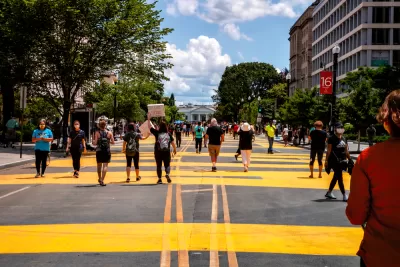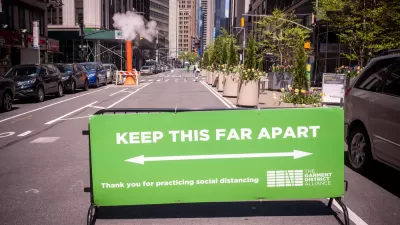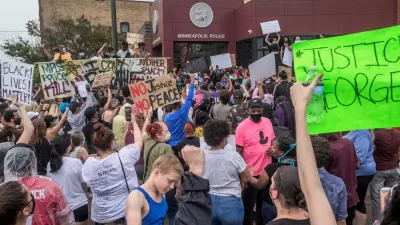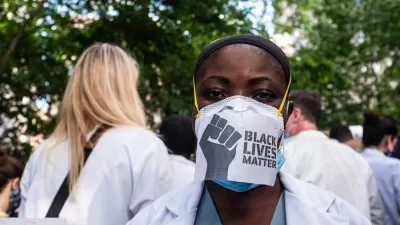A leading advocate for a new, equity centering approach explains how plans to redesign streets for the needs of the coronavirus pandemic left behind racial justice as a secondary concern.

Dr. Destiny Thomas writes for CityLab to explain and illustrate the advocacy for a new kind of attention to be paid to social justice and public safety for Black Americans as planners and advocates press for planning innovations in the public realm.
It's not enough to equate traffic safety and bike and pedestrian and bike infrastructure with social justice, according to Thomas, given the realities of racism in the United States.
The quick deployment of slow streets, al fresco streets, and open streets in the first months of the coronavirus was already raising alarms for Thomas, along with others, before the killings of Ahmaud Arbery and George Floyd shifted public awareness from the pandemic to racial justice:
But to me, as a Black planner and community organizer, the lack of process and participatory decision-making behind these projects was an absolute nightmare. Pop-up bike lanes, guerrilla-urbanist playgrounds, and tactical walkways have been notorious for being politically crude for as long as I’ve been in the field: By design, their “quick-build” nature overrides the public feedback that is necessary for deep community support. Without that genuine engagement, I feared that pandemic-induced pedestrian street redesigns would deepen inequity and mistrust in communities that have been disenfranchised and underserved for generations.
Here, Thomas lays out the fundamental issues that undercut the progressive values intended to manifest in projects that reclaim public space from cars:
The announcement of open streets from Oakland to Minneapolis to New York City left me wondering how advocates for them would respond to data showing Black people make up 87% of those who are being criminalized in the name of “social distancing” in Brooklyn, where Covid-19 is still largely uncontained. Similarly, I thought about the ways Black, Brown, Indigenous People, people of color, as well as trans people, are regularly policed, harassed, and killed in the built environment. That violence could be heightened in spaces where the main understanding of personal safety centers on vehicle traffic, as opposed to valid concerns about racism, transphobia and xenophobia and the territorial entitlement to space that often shows up in newly gentrified communities.
The article is recommended as a clear, authoritative expression of the ideas and causes put forward by the Black Lives Matter movement where it intersects with ostensibly progressive trends in urban planning.
FULL STORY: ‘Safe Streets’ Are Not Safe for Black Lives

Maui's Vacation Rental Debate Turns Ugly
Verbal attacks, misinformation campaigns and fistfights plague a high-stakes debate to convert thousands of vacation rentals into long-term housing.

Planetizen Federal Action Tracker
A weekly monitor of how Trump’s orders and actions are impacting planners and planning in America.

In Urban Planning, AI Prompting Could be the New Design Thinking
Creativity has long been key to great urban design. What if we see AI as our new creative partner?

King County Supportive Housing Program Offers Hope for Unhoused Residents
The county is taking a ‘Housing First’ approach that prioritizes getting people into housing, then offering wraparound supportive services.

Researchers Use AI to Get Clearer Picture of US Housing
Analysts are using artificial intelligence to supercharge their research by allowing them to comb through data faster. Though these AI tools can be error prone, they save time and housing researchers are optimistic about the future.

Making Shared Micromobility More Inclusive
Cities and shared mobility system operators can do more to include people with disabilities in planning and operations, per a new report.
Urban Design for Planners 1: Software Tools
This six-course series explores essential urban design concepts using open source software and equips planners with the tools they need to participate fully in the urban design process.
Planning for Universal Design
Learn the tools for implementing Universal Design in planning regulations.
planning NEXT
Appalachian Highlands Housing Partners
Mpact (founded as Rail~Volution)
City of Camden Redevelopment Agency
City of Astoria
City of Portland
City of Laramie





























